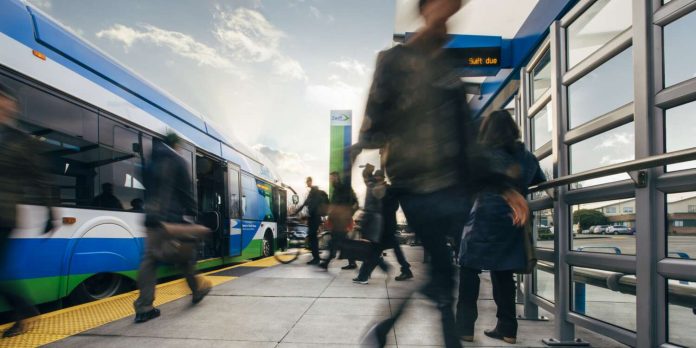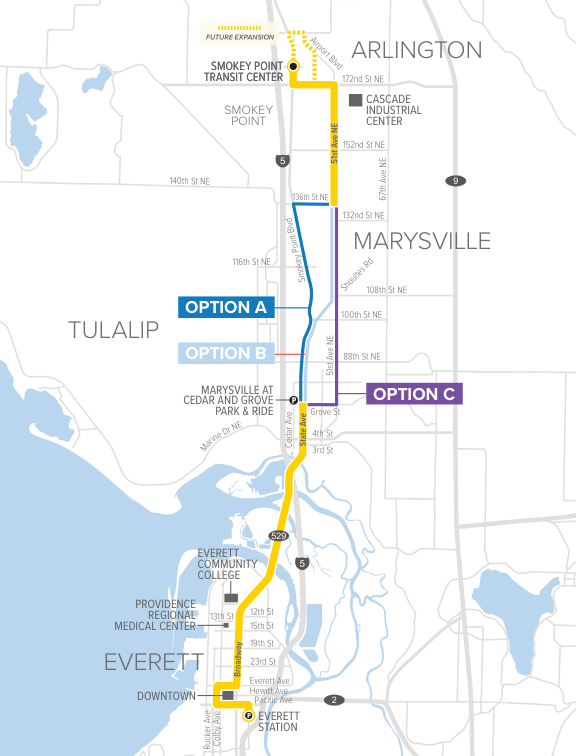
Community Transit has kicked off planning work for its fourth bus rapid transit lite line that could start service by 2029. Dubbed as the “Swift Gold Line,” the planned service will run between Everett Station and Smokey Point Transit Center in Arlington. This comes on the heels of the latest Swift line (the Orange Line) opening this past spring, which runs between Lynnwood’s forthcoming light rail station and McCollum Park Park-and-Ride.
“We are focusing on bringing our flagship service to some of the most booming areas of Snohomish County and indeed in the country,” Ric Ilgenfritz, Community Transit’s CEO, said in a statement on Thursday. “Marysville’s comprehensive plan calculations anticipate the city will grow by 35% over the next 20 years, while Arlington’s plan anticipates nearly 75% growth. By expanding access to fast, easy and reliable transportation we will keep our communities and our economy moving.”
When the Gold Line opens for service, riders can expect buses to come every 10 to 12 minutes on weekdays, and every 15 to 20 minutes on weekends and during early morning and evening periods. That’s a higher level of frequency than Community Transit offers on most other bus services, and should come with a broader span of service.
Bus stops along the Gold Line will also have superior amenities with lighting, modern bus shelters, off-board payment, and real-time arrival information signs. Those stops, however, may be fewer, with stops spread apart about every third of a mile in denser areas and every half-mile in low density areas. Consequently, Community Transit is contemplating around 20 to 27 stop pairs along the whole corridor. That’s comparable to Route 201, which the Swift line would potentially replace, but fewer than Route 202, a variant of the Route 201 that could also potentially be replaced.
Three alternatives are being studied for the new Gold Line, with the main difference being the routing through Marysville. Starting from Marysville’s Cedar and Grove Park-and-Ride, the alternatives shake out as follows:
- Option A would direct the route further along State Avenue and Smokey Point Boulevard NE as far as NE 136th Street NE. The corridor is stroady with strip commercial and low density uses, with poor access to the west due to parallel rail corridor limiting crossings and cut into the walksheds and bikesheds.
- Option B would direct the route further along State Avenue but only as far as 100th Street NE before turning onto Shoultes Road and 51st Avenue NE. This alignment has fewer strip commercial areas along the way and doesn’t suffer as much from the rail corridor, but is relatively low density and impacted to the west by a stream corridor that similarly limits walksheds and bikesheds.
- Option C would direct the route immediately east into denser parts of Marysville along Grove Street (72nd Street NE) until reaching 51st Avenue NE and heading north. The walksheds and bikesheds of this option are much better than the other options, but once the route reaches 51st Avenue NE there’s mostly only low density uses.
In all cases, however, between Everett Station and Cedar and Grove Park-and-Ride, the line would mostly be routed along Broadway in Everett and State Avenue in Marysville via SR 529. Although, there would be a major deviation between Everett Station and Broadway via Downtown Everett as part of a coverage strategy by Community Transit. Between northern Marysville and Smokey Point, the line would be routed along 51st Avenue NE and 172nd Street NE.
This would leave out a connection to Arlington’s city center, but offer connections to local bus routes. Nevertheless, Community Transit does have a concept to potentially extend Gold Line service further, but only by a few blocks to the north to serve a denser residential area.
In terms of added speed and reliability, Community Transit is contemplating use of transit signal techniques, business access and transit (BAT) lanes, and potentially exclusive center-running bus lanes. The latter would put some stations in the middle of the street and could be achieved with either dual bus lanes or strategic use of single bus lanes where employed.
For now, Community Transit has launched an online open house on the options and is taking public feedback on the options through Wednesday, August 7. Several rounds of public engagement will follow with more details, including defined stop locations and improvements, and selection of a preferred route.
Stephen is a professional urban planner in Puget Sound with a passion for sustainable, livable, and diverse cities. He is especially interested in how policies, regulations, and programs can promote positive outcomes for communities. With stints in great cities like Bellingham and Cork, Stephen currently lives in Seattle. He primarily covers land use and transportation issues and has been with The Urbanist since 2014.



